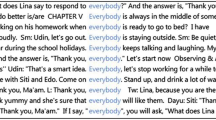
Overview
- Examines a cross-section of the bestselling series in English language children's literature of the last 60 years
- Uses the quantitative methods of Corpus Linguistics in combination with Critical Discourse Analytic interpretation
- Shows how gendered constructions of identity are built on uneven patterns of representation
Part of the book series: Palgrave Studies in Language, Gender and Sexuality (PSLGS)
Access this book
Tax calculation will be finalised at checkout
Other ways to access
About this book
This book examines how aspects of gender and identity are represented in some of the best-selling children's book series published in English over the last 100 years. Combining the quantitative methods of corpus linguistics with Critical Discourse Analytic interpretation, the author's analysis shows how gendered constructions of identity are built on uneven patterns of representation. Stories, and the characters who inhabit them, not only provide child readers with entertainment, but also the building blocks of their identities: linguistic choices construct representations of how to be a girl or how to be a boy, often in binary, mutually exclusive terms. Hunt's critical corpus linguistic approach uncovers patterns of representation beyond the fiction author's awareness, which reveal their assumptions about how girls and women behave, or should behave, or what boys and men do, or should do. Chapters cover the gendered patterns found in how characters speak, how they express emotion and how they act on the world, as well as those characters who contradict these patterns and perform their genders in different ways. The detailed analysis and its implications will be relevant to teachers of literature, both at school and at university level, media researchers, lecturers and students of linguistics or gender studies, and anyone interested in child development and the fiction written for children.
Similar content being viewed by others
Keywords
Table of contents (9 chapters)
-
Front Matter
-
Back Matter
Reviews
“An exemplar of its kind. Sally Hunt's careful analysis leaves no stone unturned, revealing that while we are learning to read, we are also learning about gender, often through subtle repetitions in language. It is fascinating to see a different side of so many of the books that filled my childhood.” (Paul Baker, Lancaster University, UK)
“From agency to appearance to emotionality (and beyond), this book offers a multifaceted analysis of gender in bestselling English-language children’s books, including a refreshing glimpse into gender non-conforming characters. An ideal showcase for the power of corpus linguistics to uncover repeated patterns of representation that underpin the gendered nature of our social world as reflected, constructed and (very occasionally) challenged in children’s literature.” (Monika Bednarek, Sydney University, Australia)
Authors and Affiliations
About the author
Sally Hunt is a Staff Tutor and Lecturer in Applied Linguistics at the Open University, UK. She specialises in discourse analysis, corpus linguistics, and language and gender. Her research focuses on the ideological analysis of media, particularly fiction, with an emphasis on the representation of intersectional aspects of identity such as gender and race.
Accessibility Information
Bibliographic Information
Book Title: Linguistic Representations of Gender in Children's Literature
Book Subtitle: Feeling, Speaking, Doing
Authors: Sally Hunt
Series Title: Palgrave Studies in Language, Gender and Sexuality
DOI: https://doi.org/10.1007/978-3-031-76662-6
Publisher: Palgrave Macmillan Cham
eBook Packages: Social Sciences, Social Sciences (R0)
Copyright Information: The Editor(s) (if applicable) and The Author(s), under exclusive licence to Springer Nature Switzerland AG 2024
Hardcover ISBN: 978-3-031-76661-9Published: 26 February 2025
Softcover ISBN: 978-3-031-76664-0Due: 12 March 2026
eBook ISBN: 978-3-031-76662-6Published: 25 February 2025
Series ISSN: 2947-9169
Series E-ISSN: 2947-9177
Edition Number: 1
Number of Pages: XV, 235
Number of Illustrations: 17 b/w illustrations, 2 illustrations in colour
Topics: Sociolinguistics, Children's Literature, Gender Studies, Stylistics



